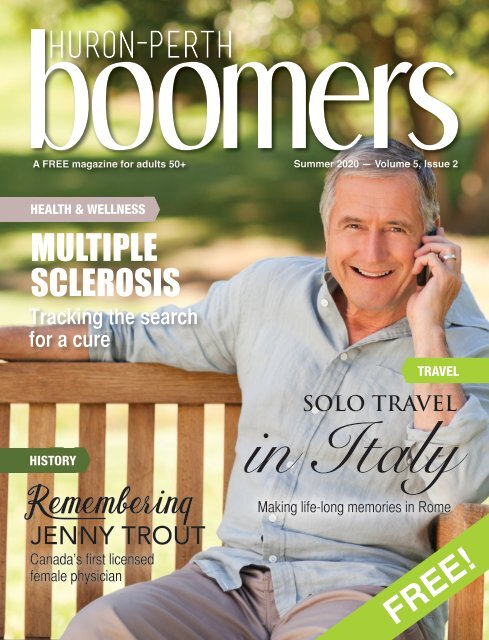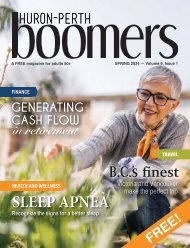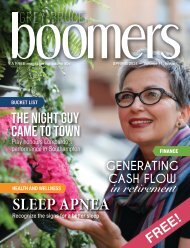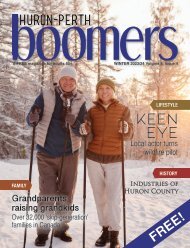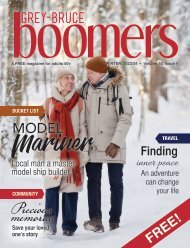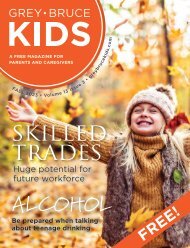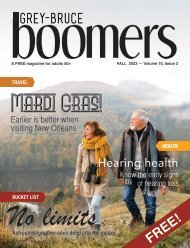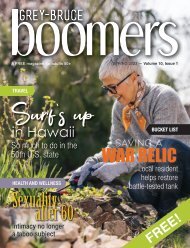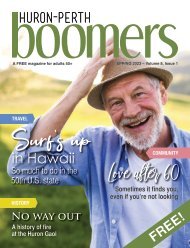Create successful ePaper yourself
Turn your PDF publications into a flip-book with our unique Google optimized e-Paper software.
A FREE magazine for adults 50+<br />
Summer 2020 — Volume 5, Issue 2<br />
HEALTH & WELLNESS<br />
MULTIPLE<br />
SCLEROSIS<br />
Tracking the search<br />
for a cure<br />
TRAVEL<br />
HISTORY<br />
SOLO TRAVEL<br />
in Italy<br />
Remembering<br />
JENNY TROUT<br />
Canada’s first licensed<br />
female physician<br />
Making life-long memories in Rome<br />
FREE!
NEW NORMALS, NEW HOPE,<br />
NEW HOMES.<br />
Now more than ever,<br />
live in a home you love.<br />
GENERAL<br />
CONTRACTOR<br />
CONSTRUCTION<br />
MANAGEMENT<br />
DESIGN BUILD<br />
CUSTOM HOME<br />
BUILDER<br />
REAL ESTATE<br />
DEVELOPMENT<br />
LEASEBACKS<br />
Peter J. Hyde<br />
HYDE CONSTRUCTION LIMITED<br />
258 Burritt Street, Stratford, Ontario<br />
Tel: 519-271-1771 info@hydeconstruction.com
FROM THE PUBLISHER<br />
As a community, we’ve seen our lives turned upside down by the COVID-19<br />
pandemic. The “new normal” has produced a great deal of anxiety and<br />
uncertainty, and the summer is shaping up to be much different from anything<br />
we’ve experienced. Seniors and those who care for them are especially vulnerable.<br />
News coverage about outbreaks in long-term care homes is heartbreaking and,<br />
frankly, the situation is unacceptable.<br />
At Boomers, we’ve adapted as best we can to the crisis. Out of an abundance of<br />
caution, we’ve decided to pause print distribution and offer our Summer 2020<br />
issue exclusively online. You’ll still find the same engaging and informative content<br />
you’ve come to expect from us, and we hope you’ll share the link to the magazine<br />
with your friends and family on email and social media.<br />
CONTENTS<br />
Travelling Italy • 6<br />
If These Walls Could Talk • 12<br />
Multiple sclerosis • 16<br />
Jenny Trout • 22<br />
Mental health • 26<br />
Recipe • 30<br />
April Taylor from Stratford brings us a beautifully-written piece about solo travel<br />
in Italy, with plenty of tips for how you can do the same when safe (Page 6). John<br />
Melady, a noted author from Egmondville, provides a fantastic story about Jenny<br />
Trout, the first licensed female physician in Canada, who grew up in Perth County<br />
(Page 22), while Jodi Jerome brings us an in-depth look at Ercildoune, an intriguing<br />
19th century home in St. Marys that has inspired poetry and legend (Page 12). We<br />
also dive deep into the symptoms, effects and prevalence of multiple sclerosis, a<br />
debilitating autoimmune disease that affects an estimated 77,000 Canadians (Page<br />
16). Also, as we navigate the pandemic, it’s important to take care of our mental<br />
health. Kathie Donovan provides several helpful tips for mental wellness during<br />
this difficult time (Page 26).<br />
COVID-19 has impacted us all in unique ways, but we need each other now as<br />
much as ever before. My hope is these stories will<br />
engage, delight and entertain you as we work toward<br />
a more stable world that more closely resembles the<br />
one we had just a few months ago.<br />
4 • HURONPERTHBOOMERS.COM<br />
Publisher<br />
Amy Irwin<br />
amy@huronperthboomers.com<br />
Huron-Perth Boomers welcomes<br />
your feedback.<br />
EMAIL<br />
amy@huronperthboomers.com<br />
PHONE 519-524-0101<br />
MAIL<br />
P.O. Box 287, Ripley, ON N0G 2R0<br />
Amy Irwin, Publisher<br />
Huron-Perth Boomers<br />
Editor<br />
Ben Forrest<br />
ben.r.forrest@gmail.com<br />
Magazine Design<br />
Becky Grebenjak<br />
SUMMER 2020<br />
Huron-Perth Boomers is distributed for free in Huron and Perth<br />
counties, and is published each March, June, September, and<br />
December. Distribution of this publication does not constitute<br />
endorsement of information, products or services by Huron-Perth<br />
Boomers, its writers or advertisers. Viewpoints of contributors<br />
and advertisers are not necessarily those of the Publisher. Huron-<br />
Perth Boomers reserves the right to edit, reject or comment on all<br />
material and advertising contributed. No portion of Huron-Perth<br />
Boomers may be reproduced without the written permission of<br />
the Publisher.<br />
CONNECTED.SUPPORTED.LOVED<br />
Your support and kindness is appreciated and keeping our spirits up!<br />
We feel loved and well cared for thanks to all of you, our Harbour Hill<br />
INDEPENDENT LIVIN G<br />
Family and the community of Goderich.<br />
Thank you<br />
104 Suncoast Drive, Goderich<br />
Harbourhillsuites.com • 519-440-0110<br />
Personal Virtual Tours Available, mbennett@harbourhillsuites.com
HEALTH & WELLNESS<br />
by Kathie Donovan<br />
HEALTH & WELLNESS<br />
Positivity in<br />
uncertain times<br />
WE CAN USE COMPASSION, EMPATHY AND KINDNESS<br />
TO CALM OURSELVES AND HELP OTHERS<br />
BY KATHIE DONOVAN<br />
enabling us to navigate with compassion, empathy and<br />
kindness for ourselves and for everyone around us. It’s my<br />
view that these qualities are our true nature. But when fear<br />
takes over, we overlook them because we go into survival<br />
mode and focus on our primal needs. When we ask fear<br />
to take a back seat, we create space for our superpowers<br />
of empathy, compassion and kindness to support us in<br />
keeping fear managed.<br />
“If you want others to be happy, practice<br />
compassion. If you want to be happy, practice<br />
compassion.” – Dalai Lama<br />
Compassion arises when we feel for someone in a<br />
challenging situation without experiencing it ourselves.<br />
Empathy flows when we put ourselves in someone else’s<br />
shoes and feel the experience they’re having. In this<br />
unprecedented time, empathy is everywhere because we<br />
are all experiencing the same threat, so we can appreciate<br />
how each other feels. Both of these beautiful human<br />
qualities come quite naturally to us, but when fear is<br />
In this extraordinary time, are you feeling unsettled or<br />
uncomfortable? I know I am.<br />
For many of us, this disturbing feeling is a reflection of<br />
what’s going on in our world, where we don’t know much<br />
for sure. The fundamental fear we’re experiencing has an<br />
important role to play for our survival and protection.<br />
But fear is a trickster. It can make us do and say strange<br />
things. Let’s not ignore or repress fear; rather, let’s call<br />
fear out and face it head on. Let’s get clear about what<br />
we’re really afraid of, and name it. If we’re afraid of<br />
getting sick, remember that none of us is in charge of<br />
the novel coronavirus, only our thoughts about our own<br />
wellness. So, a better focus for our thoughts would be on<br />
our wellness, right? The idea of naming what we’re afraid<br />
of takes away some of its power and puts us in charge of<br />
our thoughts, words and actions.<br />
Calling out fear, the con artist, helps us gain perspective,<br />
www.OntariosWestCoast.ca<br />
SUMMER 2020 • 7
HEALTH & WELLNESS by Kathie Donovan by Kathie Donovan HEALTH & WELLNESS<br />
present we have to make an extra effort to lead with them<br />
rather than leading with fear.<br />
“I choose the path of kindness. The more you<br />
extend kindness to yourself, the more it will<br />
become your automatic response to others.”<br />
– Dr. Wayne Dyer<br />
If you bump up against a challenge with another person<br />
either in their behaviour or something they say, remind<br />
yourself that, just like you, this person is doing their best<br />
to do their best. Call on your endless supply of kindness<br />
and compassion to help you navigate and be mindful of<br />
your words. If what you want to experience from others is<br />
kindness and compassion, make the first move and watch<br />
what happens.<br />
Just like the coronavirus spreads in ways we don’t fully<br />
understand, kindness spreads too. An investigative<br />
team from the World Health Organization placed the<br />
reproduction number of the novel coronavirus at between<br />
two and 2.5. This means that every person who spreads<br />
the virus spreads it to as many as 2.5 people. It’s been said<br />
the contagion factor for an act of kindness is five, which<br />
means that every act of kindness impacts five people and<br />
when we multiply, just like compound interest, kindness<br />
can be a very powerful force.<br />
“We can’t control the wind but we can adjust<br />
the sails.”<br />
We can’t personally control the virus but we certainly can<br />
control our thoughts and face our fears head on. When<br />
we focus on how we can be of service in a very positive<br />
way for others, there’s no end to what we can do to make<br />
a difference.<br />
Acts of kindness can be as simple as smiling, writing a<br />
note, making a phone call, giving someone a compliment<br />
or simply listening. Remember how kindness spreads and<br />
how good you feel when someone shows you kindness;<br />
then ask yourself how you can get busy ensuring we have<br />
more than enough kindness to go around.<br />
So, what else can we do to help ourselves and our<br />
community? Well, first of all, it’s important to be<br />
informed, but equally important to not allow ourselves to<br />
become overwhelmed. Watching news all day is not good<br />
medicine for us on any level. So check in, but don’t stay<br />
too long. Change the channel… but to what?<br />
How I’m managing my stress during these<br />
uncertain times<br />
I’m minimizing exposure to drama in the media and in<br />
conversations with other people. Be a leader and control<br />
the dialogue. Yes, it is scary, but let’s all do our best to stay<br />
in the present and not get too far ahead of ourselves.<br />
I don’t mean to disregard reality, but it’s important to<br />
surround yourself with positive energy and give your<br />
thoughts a positive focus. It could be watching a funny<br />
movie, cat videos, uplifting interviews or speaking with<br />
people you know who are positive. It can also help to read<br />
articles like this to stay focused on what you can do to<br />
help yourself and those around you.<br />
It’s important to stay connected to one another, and<br />
technology provides us with so many options. We can stay<br />
“in community” without having to be irresponsible. The<br />
elderly are our most vulnerable. If you think of someone<br />
who may need some groceries or a meal, call them and<br />
make the offer. Just the sound of a happy voice will settle<br />
them down. I’m sure they will appreciate knowing they<br />
are not alone in this.<br />
Ask for help if you need it. Believe me; someone is waiting<br />
for you to ask.<br />
Thanks to online ordering, electronic banking and all the<br />
delivery services out there, we should be able to get what<br />
we need, even if we are self-isolating.<br />
Watch your caffeine intake — it can create anxiety in the<br />
body, and we want to minimize that. Choose herbal tea<br />
or water instead. Make sure you’re eating a healthy diet,<br />
which means minimal refined carbohydrates, especially<br />
sugar.<br />
Practice or learn how to use your breath to calm your<br />
body. Meditate to calm your thoughts and body.<br />
Watch the negative self-talk and potential criticism of<br />
others. As we’ve seen, fear is a trickster. It can make us<br />
feel like we’re doing the right thing when in truth, the<br />
right thing is always to be kind to ourselves and everyone<br />
else.<br />
Finally, use your thoughts to focus on gratitude for people<br />
on the front lines of this virus — gratitude for their service<br />
and courage.<br />
I’m grateful for them and I’m grateful for you. Be well;<br />
live well.<br />
Kathie Donovan is an author, expert on happiness, and wellness<br />
ambassador for Nautical Lands Group of Companies, of which<br />
Harbour Hill Retirement Suites belongs. Learn more the services<br />
Harbour Hill provides for local seniors at www.harbourhillretirement.<br />
ca and Kathie at www.kathiedonovan.com.<br />
Purchase your Dream Home Now!<br />
EXCLUSIVE 55+ ADULT COMMUNITY<br />
Master planned community of 55 townhomes and Activity Centre in natural wooded<br />
All home plans range from 1,295 to 1,620 square feet.<br />
New homes and re-sales available!<br />
Call (519) 565-4542 for an Appointment<br />
Bayfield Mews Lane, Bayfield<br />
www.bayfieldmews.ca<br />
8 • HURONPERTHBOOMERS.COM SUMMER 2020 • 9
TRAVEL<br />
by April Taylor<br />
love this umbrella — clear, plastic and shaped like a<br />
I bubble. It covers my shoulders, I can see through it<br />
and, best of all, it never blows inside-out on windy days.<br />
And windy it was — raining cats and dogs — on a<br />
November day in Rome. Who would think I could find<br />
sheer bliss on such a nasty day?<br />
Rome, or Roma as the Italians call it, is a magnificent city.<br />
She’s a grand old lady who has aged gracefully, layered in<br />
history and wisdom from the many centuries lived on her<br />
old, well-worn streets.<br />
At age 41, I gathered up the courage to travel there alone.<br />
It turned out to be more of a pilgrimage than a holiday.<br />
I set out from my hotel, a small albergo tucked away from<br />
the main street. Outside, my bubble umbrella protected<br />
TRAVEL<br />
me as I walked the cobblestone roadways on my way to<br />
nowhere in particular. I got lost in the maze of narrow,<br />
alley-like streets, watched the people, dodged traffic and<br />
saw the most spectacular sites. Surprises waited around<br />
every corner — fountains and sculptures, architecture<br />
from gothic to renaissance, and I hadn’t even entered an<br />
art gallery yet.<br />
I continued on. Scooters and cars splashed me as they<br />
sped past. Seeking shelter from the rain, I perused the tiny<br />
shops. I found a pasticceria (confectionery) that smelled like<br />
Dorothy’s bakery, where I went with my mom when I was<br />
a child; a store that sold only gloves; and a small hardware<br />
store that sold everything from j-cloths to ladders. It had<br />
buckets and mops piled to the ceiling. I passed designer<br />
shoe stores and high-end clothing boutiques, where<br />
chauffeurs waited for ladies as they shopped.<br />
Completed in 1762, Trevi Fountain<br />
is Rome’s most famous.<br />
SOLO TRAVEL<br />
in Italy<br />
TIPS FOR GLOBE-TROTTING ADVENTURES<br />
YOU’LL NEVER FORGET. BY APRIL TAYLOR<br />
10 • HURONPERTHBOOMERS.COM SUMMER 2020 • 11
TRAVEL by April Taylor by April Taylor<br />
TRAVEL<br />
After walking for hours, I stepped into one of Rome’s<br />
many cafés, which locals referred to as a bar. I went to<br />
the cashier and ordered a cup of hot chocolate. I took<br />
the ticket he gave me and stood at the crowded counter,<br />
where men and women gulped down their espresso and<br />
were on their way in minutes. The young man behind<br />
the counter put a small cup of thick brown liquid in front<br />
of me. It looked like thin pudding, different than any hot<br />
chocolate I’d had before, but good. I took it and sat on<br />
a stool in front of the window, out of the way of locals<br />
passing in and out of the building.<br />
It felt good to sit down and warm up. It was still raining,<br />
and my pant legs were wet up to my knees. As I sipped<br />
on my hot drink, I listened to people talking quickly and<br />
passionately in Italian. Of course I didn’t understand a<br />
word, but I thought: What a beautiful sound. One of the<br />
great things about being on holiday is having time to<br />
observe your surroundings and savour the moment.<br />
I left the bar, put up my umbrella, turned the corner and<br />
walked into Piazza Navona, a bustling square filled with<br />
street artists and tourists that dates to the 1st Century. I<br />
think my favourite places in Italian cities are the piazzas.<br />
They’re open spaces with only pedestrian traffic. Some<br />
have a fountain in the centre, and almost all have at least<br />
one café. People of all ages gather here and mingle. There<br />
are gaggles of men chatting, kids playing and women<br />
with bundle-buggies full of fresh bread and vegetables<br />
from the market.<br />
Italians have a name for this custom; it is called passeggiata,<br />
which translates to a traditional evening stroll. It is<br />
interesting that even in a city as big as Rome, this villagelike<br />
custom is still practiced. In fact, Rome seems to be a<br />
big, busy city made up of many little villages.<br />
It finally stopped raining, and so it was time to find Trevi,<br />
Rome’s most famous fountain. This Baroque masterpiece<br />
is the size of a building, designed by Nicola Salvi and<br />
finished by Giuseppe Pannini in 1762, exactly two<br />
centuries before the year I was born. Before I saw it, I<br />
could hear the water falling.<br />
There it was, surrounded with people getting their<br />
pictures taken, throwing in coins and wishing for their<br />
heart’s desires. If you toss coins into the water here, legend<br />
holds that you will return to Rome someday. Visitors toss<br />
thousands of Euros into the fountain each day, and the<br />
coins are collected, cleaned and given to charity.<br />
It was getting dark, and in the glow of the lights, the<br />
fountain looked even more spectacular. I stood and looked<br />
at it in amazement, wondering how the artists of the day<br />
could even begin to create all the sculptures, obelisks<br />
and buildings I had seen. Without the technology and<br />
equipment we have today, it seems impossible. I searched<br />
my pockets for coins, and joined the others and made my<br />
wishes.<br />
It was about 7 p.m., and I was getting hungry. There were<br />
many restaurants to choose from. All were charming and<br />
quaint, with round awnings above the doors, twinkling<br />
lights in the windows, a few tables outside on the<br />
cobblestone. Suddenly I heard a man say to me in a heavily<br />
accented voice, “You look like Alice in Wonderland.”<br />
I laughed and said that was exactly how I felt. Selfconsciously,<br />
I entered a restaurant. A waiter in a crisp<br />
white shirt and black vest and bow tie seated me at a small<br />
table.<br />
Dining can be an awkward part of travelling alone,<br />
but there I was — alone and hungry, half a world from<br />
home and happy as I had ever been. The restaurant was<br />
suspiciously not busy. I have since learned Italians don’t<br />
eat dinner until at least 9 p.m. I ordered lemon pasta, a<br />
flavour I had never experienced. Delizioso! The waiter bid<br />
me bouna notte and I stepped out into a hub of activity.<br />
There is always a lot of action in the streets of Rome,<br />
no matter the hour. The shops are open late, selling<br />
souvenirs; people eat gelato, smoke and drink espresso.<br />
I’ve heard it said that Romans use the piazzas as outdoor<br />
living rooms.<br />
I meandered back to the hotel, absorbing all that I had<br />
seen that day. In spite of being tired and the fact my feet<br />
were sore, I felt exhilarated and alive — like a part of me<br />
I didn’t even know about had been asleep, and Roma, the<br />
grand old lady, shook me awake.<br />
It has been many years since my first solo journey to<br />
Rome. I continue to travel alone and have learned ways<br />
to make it very enjoyable and to meet new and interesting<br />
people from all over the world.<br />
12 • HURONPERTHBOOMERS.COM SUMMER 2020 • 13
TRAVEL by April Taylor by April Taylor<br />
TRAVEL<br />
Tips<br />
for<br />
travelling<br />
Stay in a central location<br />
alone<br />
I find this a simple and safe way of travelling. It<br />
eliminates the need to use public transportation. It<br />
is easy to return to the hotel to rest and freshen up<br />
and to leave any purchases you may have made.<br />
Hotels vs AirBnb<br />
Both have their pros and cons. An apartment<br />
rented through AirBnb provides a kitchen, laundry<br />
and privacy; however, there may not be anyone to<br />
help you if require assistance. I do like the feeling<br />
of living like a local when I stay in an apartment.<br />
On the other hand, a hotel provides comfort and<br />
security. I do like having someone to ask for help<br />
with making reservations or calling a taxi, especially<br />
if I am somewhere I don’t speak the language. Also,<br />
I like the security. If there is an emergency, I have<br />
someone to help.<br />
By taking one, you are instantly among like-minded<br />
people who share the same interests as you, making<br />
it easy to connect and make friends. There are day<br />
courses or ones that last weeks or even months.<br />
Originally I combined a course related to my work.<br />
That was good, but sometimes I want to do something<br />
completely different.<br />
My favourite course is Italian language. I have done<br />
this several times. It gives my holiday a purpose and<br />
structure to the day while still allowing plenty of time<br />
for sightseeing and shopping. There are often other<br />
solo travellers of a similar age. I always find someone<br />
to hang out with and share dinner with.<br />
Tours<br />
Tours are an easy way to get around the country and<br />
see the highlights. Again, there are pros and cons. A<br />
tour offers simplicity and security, but you are tied to<br />
the schedule.<br />
Day tours and excursions<br />
I like this option. It allows me to be independent but<br />
visit a place I want to see without having to figure<br />
out how to get there. The tour company will often<br />
pick you up at the hotel or meet in an easy central<br />
location. I enjoy the company of others for a day but<br />
I am not tied to a week tour.<br />
Editor’s note: The author took this trip prior to COVID-19<br />
travel restrictions. Please follow all government guidelines when<br />
travelling.<br />
April Taylor is a freelance writer and hairstylist in Stratford<br />
who loves to travel.<br />
Register for a course<br />
It seems there are programs or courses in almost<br />
everything, from sports to art, cooking and more.<br />
14 • HURONPERTHBOOMERS.COM SUMMER 2020 • 15
HISTORY<br />
by Jodi Jerome<br />
HISTORY<br />
IF THESE<br />
WALLS<br />
COULD<br />
TALK...<br />
ST. MARYS’ ERCILDOUNE<br />
BY JODI JEROME<br />
Photograph courtesy<br />
St. Marys Museum<br />
& R. Lorne Eedy<br />
Archives, St. Marys.<br />
railway’s arrival, seeing an opportunity to transform himself into a grain<br />
dealer with courage, sharp business insight and a golden tongue.<br />
In 1903, William Johnston, Perth County clerk and historian, wrote, “Of<br />
all these (grain) speculators Carter was both the most daring and the most<br />
successful. His name was so inextricably linked with this (grain) market that<br />
in his heyday St. Marys was dubbed ‘Carter’s Corner.’”<br />
Carter built a cache of cash and reputation, which he used to diversify from<br />
a grain buyer into the owner of many mills and businesses.<br />
As his personal fortune grew, so did his desire to elevate his family into St.<br />
Marys’ high society. One of the prerequisites for entrance was a mansion<br />
designed by a recognized architect.<br />
In 1868, just a decade after the arrival of the railway, Carter bought Lots 4-6<br />
from Jones. He hired London, Ont., architect William Robinson to design<br />
and oversee construction of an Italianate villa that overlooked the main<br />
street, river and the town. It would be similar to St. Marys’ Milner Harrison<br />
house at 322 Emily St., which was inspired by Jones’ 1833 Toronto villa.<br />
Carter’s two-storey square Italianate home had two fronts. The street and<br />
garden were surrounded by lacy verandas, accessed by interior French doors.<br />
They overlooked its ample grounds, gardens and elaborate gothic windowed<br />
summer folly. The high-ceiling rooms were filled with light and marble<br />
fireplaces, a walnut staircase dominated the front entrance and a roof topped<br />
with iron cresting. Inside 224 Jones St. E., George and his wife, Elizabeth<br />
(Creighton) Carter, planned the growth of their business empire from within<br />
the family.<br />
The house at 236 Jones St. E., St. Marys, is intriguing for its appearance, history and ability<br />
to inspire poetry and legend.<br />
Its first legend is the story of a man’s love for a woman who captured his heart and followed<br />
him into the wilderness. The man is Thomas Mercer Jones, early land commissioner of the<br />
Canada Company, and his wife, Mary (Strachan) Jones.<br />
There is no doubt in the truth that Jones Street was named after Thomas and Mary Mercer<br />
Jones. At the 1851 St. Marys land sale, Thomas bought Lots 4-6, a block bordered by Jones,<br />
King, Elgin and Peel streets, from James Ingersoll, “in trust for his wife, Mary Jones, her<br />
heirs and assigns.” The land remained vacant while St. Marys prospered.<br />
The arrival of the Grand Trunk Railway in 1858 and its connection to Sarnia and the<br />
waters of the Great Lakes in 1860, created an explosion of opportunity. Thus begins the<br />
setting for the home’s second legend, a rags to riches story, complete with a kingdom and a<br />
tower. In 1851, when Lots 4-6 first sold, George Carter was a married farmer in Biddulph<br />
Township, which was part of Huron County at the time. By 1857, George Carter relocated<br />
his growing family to St. Marys and established a grain business, one year ahead of the<br />
Lasting Legacy<br />
the Promise of Tomorrow<br />
Ordinary people show Extraordinary generosity by<br />
leaving legacy gifts to our hospital in their wills<br />
George and Elizabeth had six children: Harriet Ellen (Carter) Freeman<br />
(1850-1930), Elizabeth Jane (Carter) Jameson (1852-1888), James Henry<br />
Carter (1853-1905), David W. Carter (1855-1856), Anna Maria Carter (1859-<br />
1864), and Charlotte (Carter) Rice (1862-1941). Only four of their children<br />
‘Ask about our 10 Year Impact Funds’<br />
SGHFOUNDATION.ORG<br />
519.272.8210 EXT. 2626<br />
16 • HURONPERTHBOOMERS.COM SUMMER 2020 • 17
HISTORY<br />
by Jodi Jerome<br />
by Jodi Jerome<br />
HISTORY<br />
survived to adulthood. With only<br />
one heir, George needed<br />
more sons in the family<br />
business. George<br />
and Elizabeth<br />
used their large<br />
land holdings<br />
in St. Marys’<br />
fashionable<br />
section to entice<br />
their sons-inlaw<br />
to join the<br />
family business,<br />
George Carter &<br />
Son Company. Seen by<br />
the community as wedding<br />
presents, the sons-in-law who<br />
joined the business were gifted land<br />
and a large mansion of their design filled with<br />
furnishings. On Lots 4-6, Carter built himself a fiefdom<br />
with himself as king.<br />
The Rice family, courtesy St. Marys Museum &<br />
R. Lorne Eedy Archives, St. Marys, Ontario.<br />
In 1875, George gave his daughter, Harriet “Hattie,” and<br />
her new husband, former hardware merchant Clarence<br />
Freeman, the property at 217 East St. S. James Carter<br />
married Mary Box on Dec. 13, 1876, and they moved<br />
into their beautifully crafted home at 67 Peel St. in 1883.<br />
Elizabeth Jane married Hugh Alfred Jameson, a teacher,<br />
on Dec. 20, 1876, and the couple received the deed for<br />
236 Jones St. E. for $1. Elizabeth and Hugh moved to the<br />
town of Mitchell, where Hugh worked as a grain buyer<br />
for G. Carter & Son Co. When Elizabeth died in 1888,<br />
Hugh moved to the U.S. to work in publishing.<br />
In September 1881, after the Dec. 22, 1880, marriage of<br />
Charlotte “Lottie” Carter to Henry Lincoln Rice, a man<br />
with a bachelor of arts degree from Victoria College at<br />
the University of Toronto and two years of experience<br />
teaching classics at Vienna High School and the Galt<br />
Collegiate Institute, the Jamesons transferred their lot<br />
into Charlotte Rice’s name for $500. Henry L. Rice<br />
stopped teaching the classics and began working for G.<br />
Carter & Son Co. In 1882, their daughter, Kathleen Rice,<br />
was born. By 1885, the Rice family was ensconced in<br />
their lovely Second Empire home, designed by St. Marys<br />
clerk and architect William Williams. This house was so<br />
treasured by all its occupants, the 1881 designs for the<br />
house, signed by the architect,<br />
still exist.<br />
The house, set back on<br />
its corner lot, had a<br />
slate mansard roof<br />
on its second floor<br />
and a threestorey<br />
tower<br />
crowned with<br />
intricate iron<br />
cresting around<br />
its widow’s<br />
walk. There were<br />
beautifully curvetopped<br />
and circular<br />
windows on the second<br />
floor of the house and a lovely,<br />
lacy-edged porch, accessible from<br />
the first and second floors. The house was<br />
charmingly asymmetrical with randomly-placed large,<br />
deep bay windows, each with their own interior privacy<br />
dividers. When pulled shut, each created a roomy nook.<br />
Inside were a wealth of fine details like an imported<br />
mahogany central staircase, main room entrances<br />
enhanced with mahogany and India-sourced gumwood<br />
fretwork, oak floors inlaid with walnut harvested from the<br />
grove that had grown on Lots 4-6, richly-carved window<br />
surrounds in mahogany, oak and walnut, inside shutters<br />
and six marble fireplaces.<br />
This house seems to be a mirror of the romantic English<br />
scholarly mind of Henry L. Rice. He was freshly out<br />
of university and the classroom, still immersed in the<br />
thoughts and ideas of the great writers and well-versed<br />
in the mythological connection of the Rice family to<br />
the original, surviving families of the Mayflower that<br />
first landed in the Americas in 1620. The house reflects<br />
the man he was before being drawn into the whirlwind<br />
business that was G. Carter & Son Co.<br />
Sadly, the Rice family did not spend long in the house<br />
built just for them. When George Carter died in 1889,<br />
the Rice family moved into Charlotte’s parents’ house at<br />
224 Jones St. E., and never moved out. Henry Rice sold<br />
the furnishings of 236 Jones St. E. in a public auction<br />
May 4, 1889, and sold the house to lumber merchant<br />
James Armstrong for $4,850 on May 15, 1889. Thomas<br />
The Sparks family and friends, on<br />
Ercildoune’s Porch, circa 1920,<br />
courtesy St. Marys Museum<br />
& R. Lorne Eedy Archives, St.<br />
Marys, Ontario.<br />
Sparks, the house’s third owner, bestowed the property<br />
with its legend-laden name, “Ercildoune.” Thomas<br />
Sparks’ family, including Eugenia Mary “Birdie” Sparks,<br />
his daughter from his first marriage, and his third wife,<br />
Caroline “Carrie” Shaw’s children — George Lindsay,<br />
Barbara, Isabella (Bella), and Mary D. — came to St.<br />
Marys in 1892. When they moved into 322 Emily St. from<br />
Lakeside, Nissouri East Township, in Oxford County, his<br />
wife, Carrie, nicknamed it the Vatican due its ample size.<br />
In 1904, when Berwickshire, Scotland, native Dr. Thomas<br />
Sparks, bought 236 Jones St. E. from James Armstrong for<br />
$3,000, the house with a tower became Ercildoune, named<br />
after a town in Scotland (now called Earlston).<br />
In Berwickshire, on the Scottish borderlands, in a stone<br />
tower house, lived a real Scotsman named Thomas<br />
Learmonth, a 13th Century laird, born circa 1220, known<br />
as Thomas the Rhymer or Thomas of Ercildoune. His<br />
poetry has survived, and was said to have predicted the<br />
death of King Alexander III in 1286, the Scottish victory<br />
at the Battle of Bannockburn in 1314, the succession<br />
of Robert the Bruce to the throne and the abdication<br />
of Mary Queen of Scots in 1568. His story and poetry<br />
credit his prophetic poetic powers to an encounter he had<br />
with the Queen of Elfland.<br />
Dr. Thomas Sparks’ purchase of 236 Jones St. E., with<br />
its nooks, crannies and whimsical tower, appealed to the<br />
doctor’s poetic ambitions. While Dr. Sparks tended to his<br />
patients, he captured his impressions of St. Marys in his<br />
poetry, which appeared in the local newspaper and in<br />
early histories of Perth County. Emily P. Weaver’s 1913<br />
book, The Story of the Counties of Ontario, includes the first<br />
stanza of Sparks’ poem, “The Old Log House.”<br />
Rickety, shingleless, old and gray,<br />
Scathed by the storms of many a day,<br />
In a wayside spot where the wild weeds grow,<br />
Stands the old log cabin of long ago.<br />
Dr. Thomas Sparks lived in Ercildoune from 1904 until<br />
his death in 1917. His wife Carrie and later his widowed<br />
daughter, Barbara (Sparks) Baird, continued to live in the<br />
house until 1953. Barbara’s youngest sister, Mary Sparks<br />
Dyer, became the family bard, writing and publishing<br />
three books of poetry including one with a poem entitled<br />
“Ercildoune.” She wrote of her old home: “Gently with<br />
you the night wind grieves, Stirring ghosts from withered<br />
leaves, Proudly you gaze with quiet eyes, Ercildoune, you<br />
are old and wise.”<br />
Jodi Jerome is a writer, historian and heritage consultant who enjoys<br />
finding the stories people have forgotten about the places they live,<br />
and making the local landscape come alive for those who live and<br />
visit there today. Contact her at jodijerome@icloud.com<br />
18 • HURONPERTHBOOMERS.COM SUMMER 2020 • 19
HEALTH & WELLNESS by Ben Forrest HEALTH & WELLNESS<br />
MULTIPLE<br />
SCLEROSIS<br />
LEARN MORE ABOUT ONE OF CANADA’S MOST<br />
COMMON NEUROLOGICAL CONDITIONS.<br />
BY BEN FORREST<br />
It’s unclear why, but Canada has<br />
one of the highest rates of multiple<br />
sclerosis (MS) in the world.<br />
This unpredictable and debilitating autoimmune disease<br />
affects an estimated 77,000 Canadians — roughly one in<br />
every 385.<br />
It is one of Canada’s most common neurological<br />
conditions, and is three times more likely to occur in<br />
women than in men.<br />
There is no cure for MS, and the disease affects each<br />
person differently. But there is hope for a cure. As<br />
researchers learn more about what causes the disease,<br />
how to prevent it and how to repair the damage it causes,<br />
the outlook is increasingly positive.<br />
Here is a primer on the symptoms of MS, its potential<br />
causes, and expert guidance on how to manage and<br />
mitigate its effects.<br />
What is MS?<br />
MS is an autoimmune disease of the central nervous<br />
system. It causes the immune system to malfunction and<br />
attack healthy cells called myelin, a soft, white mixture of<br />
protein and fatty substances that forms an insulating layer<br />
around nerves in the brain and spine.<br />
Myelin allows electrical impulses to move quickly along<br />
nerve cells. If damaged, those impulses slow down. When<br />
the damage is substantial, and if scar tissue replaces<br />
myelin, nerve fibres can be damaged and nerve impulses<br />
may be entirely disrupted. If the damage is less severe,<br />
these impulses continue to travel with minor disruptions.<br />
It’s unclear what causes MS, but the best current<br />
evidence suggests that genetic, biological, lifestyle and<br />
environmental factors all contribute, according to the MS<br />
Society of Canada. Several hypotheses about the higher<br />
prevalence of MS in Canada have been presented, but<br />
doctors aren’t sure why it occurs more frequently here.<br />
Most people with MS are diagnosed when they are<br />
between the ages of 20 and 49, but some people are also<br />
diagnosed when they are children, or as older adults.<br />
SUMMER 2020 • 21
HEALTH & WELLNESS<br />
by Ben Forrest<br />
by Ben Forrest<br />
HEALTH & WELLNESS<br />
Symptoms<br />
In many cases, myelin damage happens in patches, which<br />
may explain the wide variety of symptoms that occur<br />
with MS. Symptoms may vary depending on what part<br />
or parts of the central nervous system are impacted.<br />
Not all people with MS will experience all symptoms, but<br />
here are the more common symptoms, according to the<br />
MS Society:<br />
Balance problems and dizziness. This is caused<br />
by lesions in areas that coordinate visual, spatial<br />
and other input that allows the body to achieve<br />
and maintain equilibrium. As a result, there is an<br />
increased risk of falls. In some cases, patients can<br />
manage this by using a walking aid.<br />
Bladder dysfunction. Lesions in the brain or<br />
spinal cord can interfere with signals between the<br />
brain and urinary system, causing incontinence.<br />
Bowel dysfunction. This symptom presents most<br />
frequently as constipation, but can also include<br />
diarrhea or a loss of bowel control. After three to four<br />
weeks of suggested interventions, “most people can<br />
develop an improved bowel performance,” the MS<br />
Society says.<br />
Cognitive Impairment. This can affect between<br />
40 and 70 per cent of people with MS. The most<br />
common cognitive changes are memory-related<br />
(especially short-term memory).<br />
Depression. This can be a concern from the time<br />
of diagnosis and throughout a person’s experience<br />
with MS. Depression is more common among people<br />
with MS than in the general population.<br />
Fatigue. Up to 90 per cent of people with MS<br />
experience fatigue, one of the most disabling<br />
symptoms. But it can often be improved with lifestyle<br />
changes, including energy conservation, counselling,<br />
mobility aids like scooters or wheelchairs, exercise,<br />
and medications.<br />
Difficulty walking. This symptom can be impacted<br />
by several others, including muscle weakness, spasticity,<br />
balance, fatigue, pain and co-ordination problems.<br />
Inflammation of the optic nerve. Also known as<br />
optic neuritis, this symptom can cause sudden visual<br />
blurring or loss of vision in one eye. Optic neuritis is<br />
the initial symptom for 16 per cent of people with MS.<br />
Pain. About half of people with MS experience<br />
pain related to their illness. This pain can take many<br />
forms, and can be managed with multi-disciplinary<br />
input.<br />
Paroxysmal symptoms. Think of this as a<br />
convulsion — a sudden increase or recurrence of<br />
symptoms. They can include tonic spasms, weakness,<br />
visual disturbance, numbness, and several other<br />
symptoms. These convulsions may last seconds or<br />
minutes and can repeat several times per day.<br />
Numbness. This is the most common sensory<br />
symptom of MS. People often wake up with an<br />
abnormal sensation in part of a limb that spreads<br />
inward toward the trunk of the body and increases<br />
in intensity. This can cause achy, burning sensations,<br />
and the feeling of tightness or “banding.” Though<br />
painful, these sensations usually respond to antiseizure<br />
medication.<br />
Sexual dysfunction. MS-related damage to nerve<br />
fibres can directly impair sexual feelings or sexual<br />
responses.<br />
Tremors. This movement disorder produces<br />
involuntary, relatively rhythmic patterns. It can affect<br />
any muscle group, including the arms, legs, trunk,<br />
head, vocal cords, jaws, lips and tongues. Tremors<br />
in MS are difficult to manage and are not reliably<br />
improved with medication.<br />
Heat intolerance. Sensitivity to increased body<br />
temperature is a symptom many people with MS<br />
experience. This symptom can emerge when<br />
sunbathing, during exercise, hot baths, fatigue, fever,<br />
emotion or any other factor that increases in body<br />
core temperature.<br />
Weakness. This is another common symptom of<br />
MS. It is related to impaired nerve conduction caused<br />
by the inflammation and/or damage of central nerve<br />
pathways.<br />
Types of MS<br />
Although every experience of MS is different, researchers<br />
have divided the illness into a few basic categories,<br />
depending on the patterns in which symptoms occur.<br />
The earliest form of MS is called Clinically Isolated<br />
Syndrome (CIS), and refers to a single episode of<br />
neurological symptoms. Multiple attacks of symptoms<br />
indicates the patient has relapse-remitting MS, the most<br />
common form at the time of diagnosis.<br />
Relapse-remitting MS (RRMS)<br />
People with RRMS experience unpredictable but clearlydefined<br />
relapses (attacks or flare-ups) when new symptoms<br />
appear or older ones get worse. These relapses can last<br />
from a few days to several months, followed by periods<br />
of remission. About 85 per cent of people with MS are<br />
diagnosed with RRMS.<br />
Progressive MS (PMS)<br />
This type of MS has two sub-types: secondary progressive<br />
MS and primary progressive MS.<br />
Secondary PMS occurs when RRMS transitions to<br />
a state when relapses and remissions no longer occur.<br />
Disability slowly and continually increases.<br />
Primary PMS is diagnosed when people accumulate<br />
disability and worsening symptoms right from the start.<br />
Progressive Relapsing MS<br />
This form of MS involves steadily worsening disease from<br />
the beginning, in addition to relapses that may or may<br />
not involve periods of recovery. For the vast majority of<br />
people with MS, the disease is not fatal. They can expect<br />
We power the<br />
future.Our long-term<br />
private investment in refurbishing<br />
our nuclear fleet will ensure Ontarians receive<br />
clean, reliable, low-cost electricity and life-saving<br />
isotopes for generations.<br />
brucepower.com<br />
22 • HURONPERTHBOOMERS.COM SUMMER 2020 • 23
HEALTH & WELLNESS by Ben Forrest by Ben Forrest HEALTH & WELLNESS<br />
Canada’s MS Society<br />
says, unequivocally,<br />
there is hope for a cure.<br />
Researchers are working<br />
to develop new therapies<br />
and examine existing<br />
therapies, investigating<br />
potential triggers for the<br />
disease.<br />
a normal or near-normal lifespan, and there are various methods for<br />
managing symptoms, in addition to disease-modifying therapies.<br />
Hope for a cure<br />
Canada’s MS Society says, unequivocally, there is hope for a cure.<br />
Researchers are working to develop new therapies and examine existing<br />
therapies, investigating potential triggers for the disease and studying the<br />
cellular mechanisms that damage or repair myelin and the underlying<br />
nerve cells. Symptom management and quality of life is also a key focus<br />
of MS research.<br />
Last year, researchers from the University of British Columbia identified<br />
12 candidate gene variants as potential risk factors for MS; many of<br />
them are clustered in immune system pathways. Health Canada recently<br />
approved a new drug treatment for active secondary progressive MS, and<br />
the MS Society continues to fund studies into the disease.<br />
While the higher-than-average prevalence in Canada remains a mystery,<br />
recent data shows that, on average, 11 Canadians are diagnosed with MS<br />
every day. The proportion of Canadians living with MS has continually<br />
increased since the first episodes of MS prevalence were reported by the<br />
Canadian Chronic Disease Surveillance System (CCDSS) in the mid-<br />
2000s.<br />
CCDSS estimates the prevalence and incidence rates of chronic diseases,<br />
including MS, after collecting administrative data from every province<br />
and territory. According to the MS Society, this data covers about 97 per<br />
cent of the Canadian population. Data for the most recent estimates were<br />
collected between 2014 and 2015.<br />
How to help<br />
Legacy giving is one of several options the MS Society uses to provide<br />
services to people living with MS and their families, as well as to fund<br />
research into the disease.<br />
Providing a gift in your will, donating securities, or naming the MS Society<br />
as the beneficiary of a life insurance policy, RRSP, RRIF, or Canada<br />
Pension assets, are all ways tot provide legacy gifts. For more information,<br />
visit mssociety.ca.<br />
This article is for informational purposes only. Contact your physician for more details.<br />
Ben Forrest is an writer and editor based in Exeter, Ont. His work has also appeared in<br />
the National Post, Broadview magazine and Sports Illustrated.<br />
SUMMER 2020 • 25
HISTORY<br />
by John Melady<br />
HISTORY<br />
Remembering<br />
JENNY TROUT<br />
CANADA’S FIRST LICENSED FEMALE<br />
PHYSICIAN GREW UP ON A FARM<br />
NEAR STRATFORD. BY JOHN MELADY<br />
U.S. Library of Congress Photo<br />
When she came to Canada, Jenny Gowanlock was<br />
six years old.<br />
Her parents had pulled up stakes in Kelso, Scotland,<br />
and were determined to make a life for themselves in a<br />
new land. In 1847, they settled on a small farm in Ellice<br />
Township, in what is today Perth East, just outside of<br />
Stratford. Once the family was established in their rather<br />
primitive homestead, Jenny attended school in town, and<br />
on Sundays went with her parents to Knox Presbyterian<br />
Church, the handsome, red brick edifice at the corner of<br />
Ontario and Waterloo streets in Stratford. Services are<br />
still held at this church, and presumably, Jenny got to<br />
know the place and the area well over the years.<br />
Much later, and long after her death, a star in her name<br />
was placed on the downtown part of the Downie Street<br />
sidewalk in Stratford. There, the star attests to her long<br />
forgotten fame, but in a different way than do other<br />
markers for better-known modern personalities such as<br />
Justin Bieber and Peter Mansbridge. Nevertheless, Jenny’s<br />
rather faded star helps remind passers-by of this amazing<br />
woman who once graced the streets of their town.<br />
As far as we know today, Jenny’s growing-up years were<br />
uneventful. She was a good student, and the marks she<br />
obtained enabled her to enter what was at the time called<br />
Normal School, where she trained to be a teacher. This<br />
was in Toronto. Once qualified as a teacher, she returned<br />
to Stratford to teach.<br />
The man who would become Jenny’s husband was<br />
teaching writing in several towns in southern Ontario,<br />
and met Jenny when he came to Stratford. His name was<br />
Edward Trout. The two fell in love and upon marriage,<br />
Jenny changed her name to his, and from that time to<br />
today, the brown-haired Scottish lass became known as<br />
Jenny Trout. To a large extent, her maiden name was<br />
forgotten, and so was her teaching job in Stratford. In a<br />
short time, the young couple moved to Toronto because<br />
26 • HURONPERTHBOOMERS.COM SUMMER 2020 • 27
HISTORY<br />
by John Melady<br />
OUR TEAM<br />
Edward felt he would have better business prospects there.<br />
Sadly, the first years of their marriage were difficult<br />
because Jenny soon became ill — so ill, in fact that she<br />
was almost bed-ridden. This was because of what were,<br />
according to the Dictionary of Canadian Biography,<br />
“nervous disorders [that] … left her a semi-invalid, barely<br />
able to move.” She apparently tried several remedies,<br />
but stumbled upon something new called electrotherapy,<br />
and her health improved because of it. It was then that<br />
Jenny decided to pursue a childhood dream of going<br />
into medicine. At the time, even the idea of a woman<br />
becoming a doctor was unheard of in Canada — but that<br />
was what Jenny wanted to be.<br />
She persisted, and enrolled as a student at what was then<br />
the Toronto School of Medicine. Unfortunately, her sex<br />
there became an immediate barrier. Male classmates<br />
scrawled “obnoxious sketches” on walls and professors<br />
even taunted Jenny and another female student, according<br />
to one of Jenny’s future protegés.<br />
It appears women were simply not wanted or welcome.<br />
In fact, the normally-reserved Jenny confronted a<br />
particularly rude professor and told him to stop his antics,<br />
or she would tell his wife about the matter. Apparently,<br />
the bad behaviour stopped.<br />
While the ill treatment was particularly annoying, Jenny<br />
refused to give up her hope of continuing in medicine;<br />
however, she felt she simply could not get anywhere in<br />
Toronto. Instead, she decided to pursue her dream at<br />
the Woman’s Medical College of Pennsylvania. The new<br />
environment suited her, and she not only succeeded in<br />
her studies, she ultimately graduated as a doctor in 1875.<br />
Then she returned to Canada, and prepared to write<br />
the matriculation exam at the College of Physicians and<br />
Surgeons in Toronto in order to get qualified to practice<br />
here. When she did so and passed, she became the first<br />
female doctor licensed to practice in Canada. This was<br />
undoubtedly a badge of honour for Stratford, and the girl<br />
from the country who had done so well.<br />
When Jenny was pursuing her studies in the U.S., Edward<br />
Trout’s financial situation greatly improved. He gave up<br />
the teaching of writing, tried several other occupations<br />
and finally joined his brother in publishing a paper called<br />
28 • HURONPERTHBOOMERS.COM<br />
the Monetary Times.<br />
Because of that venture, in time, he was able to assist<br />
Jenny in some of her endeavours.<br />
From what we know about her today, Jenny became<br />
involved in more than one venture in physical healing<br />
— particularly aimed at women. One of these was an<br />
establishment in Toronto that specialized in galvanic<br />
baths, an alternative treatment that added a gentle electric<br />
current to water. There is little record today of what this<br />
was all about, but it only lasted a short time. And another<br />
venture, a free dispensary for the poor, closed in less than<br />
a year.<br />
The soft-spoken young woman was deeply religious, and<br />
did all she could to encourage young women to become<br />
doctors. To that end, she helped found a women’s medical<br />
facility in Kingston at the same time Queen’s University<br />
was catering to the needs of men. Years later, a plaque in<br />
her honour was unveiled there.<br />
Sadly, Jenny’s health always caused trouble, and while she<br />
continued to lend her name and time to religious causes,<br />
she gave less attention to medicine. As a result, many may<br />
have encountered her without knowing about her medical<br />
career. She retired at age 41, and she and Edward moved<br />
to Florida and later to California. Amazingly, despite her<br />
almost life-long health issues, she was 80 when she died.<br />
Today, few of us may know of her, but in addition to<br />
the sidewalk star mentioned earlier, a Canadian stamp<br />
honouring her was issued in 1991 and a large medical<br />
structure exists in her name in Stratford. Brian Morrison,<br />
the building manager of the place, whom I interviewed<br />
for this article, assures me it is quite busy, and several<br />
doctors work out of it.<br />
Surely then, the Jenny Trout Centre is a fine memorial for<br />
Canada’s first licensed female physician.<br />
John Melady is the author of 13 books and many newspaper<br />
and magazine articles. He also reviewed books for the Globe and<br />
Mail for several years. His books are available through Chapters/<br />
Indigo, Amazon and other bookstores.<br />
Wayne Young<br />
President/Funeral Director<br />
GregYoung<br />
Managing Funeral Director<br />
Don Munro<br />
Funeral Director<br />
519.271.7411<br />
wgyoungfuneralhome.com<br />
David Ayers<br />
Funeral Director<br />
Tonia Catcher<br />
Pre-Arrangement & Estate<br />
Care Counselor<br />
Marcel Peper<br />
Funeral Director<br />
Basic Simple Cremation<br />
Cost of Cremation<br />
$1895.00 *NO HIDDEN FEES<br />
Contact us today to get started.<br />
• Arrangements with family/executor<br />
• Transfer from place of death (100km)<br />
• Unlimited Death Certificates<br />
• Province of Ontario Death Registration<br />
• Coroner’s Cremation Certificate<br />
• Cremation Casket • Cost of cremation<br />
• Transfer of deceased to crematorium<br />
• Transfer of cremated remains back to family/executor<br />
• Cancellation of Canada Pension and Old Age Security<br />
• Filing of CPP Death Benefit, Survivor’s<br />
Benefit and OAS Survivor’s Benefit<br />
• Funeral Home Estate Care Booklet and<br />
Meeting with Estate Care Counsellor<br />
430 Huron Street<br />
Stratford, ON N5A 5T7
FOOD & DRINK<br />
Strawberry C olada<br />
Cheesecake<br />
READY<br />
FOR YOU<br />
TODAY!<br />
CRUST<br />
1½ cups graham crumbs<br />
¼ cup butter, melted<br />
1 tbsp water<br />
CHEESECAKE<br />
2 pkg (each 8 oz) cream cheese, at<br />
room temperature<br />
½ cup granulated sugar<br />
3 eggs<br />
2 tbsp lemon juice<br />
1 tsp almond extract<br />
½ tsp vanilla<br />
STRAWBERRY TOPPING<br />
2 tbsp each granulated sugar, lime juice,<br />
rum and shredded coconut<br />
3 cups strawberries, sliced<br />
Cooking Time: 2 hours, 55 minutes<br />
Servings: 6<br />
Crust:<br />
Stir crumbs with butter and water until evenly moistened.<br />
Press onto bottom of 9-inch springform pan, creating slight<br />
upward slope at side. Bake in 350 F oven, for 10 minutes. Set<br />
aside to cool.<br />
Cheesecake:<br />
In large bowl and using electric mixer, beat cream cheese<br />
until smooth. Beat in sugar until well blended. Beat in eggs,<br />
one at a time, beating well after each addition. Beat in lemon<br />
juice, almond extract and vanilla. Pour over crust. Bake at<br />
350 F until set and golden brown around edge, between 35 to<br />
45 minutes. Run knife around edge of cake. Refrigerate for at<br />
least two hours or until chilled.<br />
Strawberry topping:<br />
In bowl, combine sugar, lime juice, rum and coconut; stir in<br />
sliced strawberries. Let stand at room temperature for one<br />
hour to blend flavours. Spoon over wedges of cheesecake.<br />
STRATFORD’S NEWEST<br />
LUXURY RENTALS<br />
RENT HERE NOW!<br />
Comprised of 52 two-bedroom suites, Perth Mills offers residents a new level of<br />
comfort, amenities and convenience of access to all that Stratford has to offer.<br />
FROM THE $1,700’s PER MONTH<br />
O’LOANE AVE / HWY 122<br />
FREELAND DR<br />
LORNE AVE W<br />
Stratford<br />
QUEENSLAND RD<br />
JOHN ST S<br />
HURON ST / HWY 8<br />
ST VINCENT ST S<br />
JOHN ST N<br />
ERIE ST / HWY 7<br />
AMENITIES<br />
• In-Suite Laundry<br />
• Tiled Tubs/Showers<br />
• Lockers<br />
• Elevator<br />
• Fully Sprinklered<br />
• Ample Parking<br />
• Dishwasher<br />
• Stainless Steel Appliances<br />
• Luxury Vinyl Plank Flooring<br />
• Granite Counters<br />
• Suite Controlled Temperature<br />
• Secure Entrance<br />
• Fitness Centre<br />
• Social Lounge<br />
LIMITED SUITES AVAILABLE!<br />
Tip: To speed up preparation time, use store-bought frozen<br />
cheesecake. Just thaw and spoon strawberry topping onto<br />
wedges.<br />
FOR LEASING INQUIRIES, CONTACT:<br />
Kim Laramie - Leasing and Marketing Manager<br />
UNLIMITED Residential Living T. 905 719 RENT (7368)<br />
Recipe courtesy of Foodland Ontario www.ontario.ca/foodland<br />
rental pricing & specifications subject to<br />
change without notice. E. & O.E. E. rental@unlimitedresidential.ca W. unlimitedresidential.ca<br />
30 • HURONPERTHBOOMERS.COM SUMMER 2020 • 31
THANK YOU<br />
for<br />
reading<br />
online!<br />
Share this link<br />
with your friends<br />
www.huronperthboomers.com<br />
Like us on<br />
Facebook and<br />
share our content<br />
Contact<br />
us for<br />
advertising<br />
info<br />
Support our<br />
advertisers<br />
Send us your feedback at<br />
amy@huronperthboomers.com<br />
A free magazine for adults 50+


